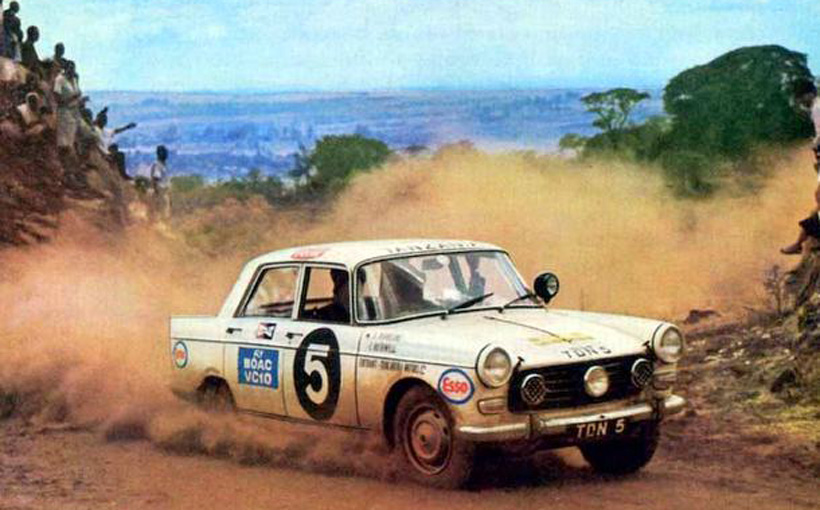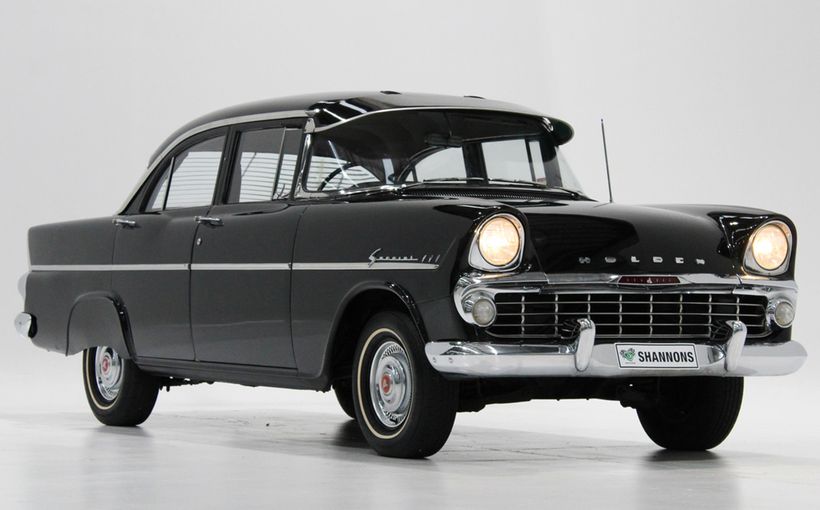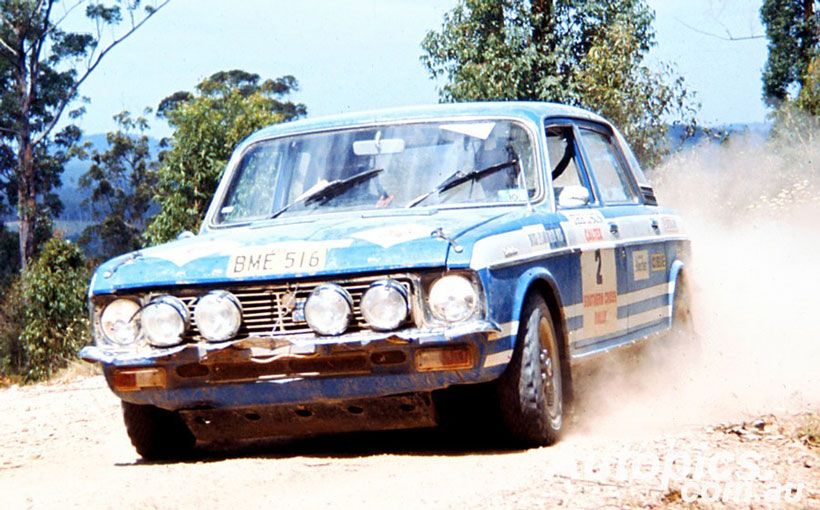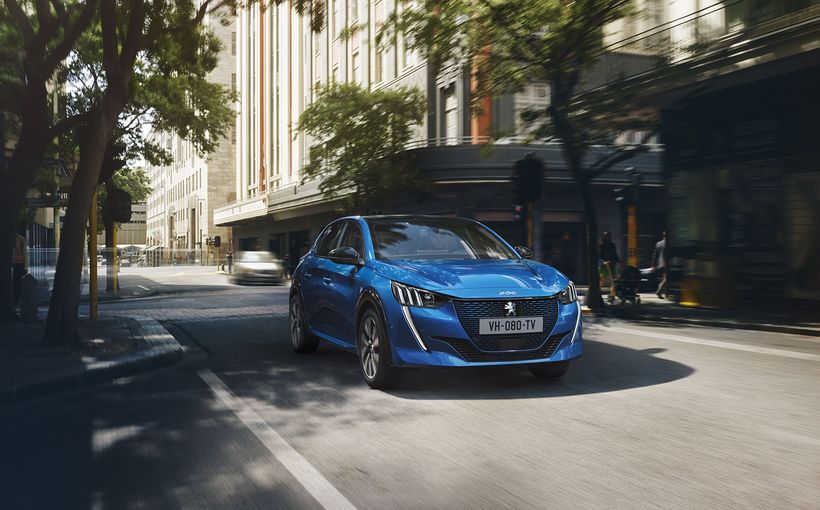Peugeot 404: Legend of the East African Safari

Cheered on by thousands of spectators cramming every vantage point, the Shankland/Rothwell Peugeot 404 Injection charges through the African dust on its way to a famous victory in 1967. On numerous occasions these French sedans defeated the potent Cortinas entered by Ford’s mighty works team. (Image from: www.maskinisten.net)
There was no tougher annual test for car manufacturers in the 1960s than the iconic East African Safari Rally, which makes the Peugeot 404’s dominance during that era a testament to its build quality and endurance which attracted a loyal following around the world - including Australia.
The 404’s revered status is justified when you realise how close rally cars were to the showroom products in those days. And the hellishly tough conditions the annual East African Safari threw at them, from roaming wildlife to rock-throwing locals, from baking hot sun and blinding dust to torrential rains, flash floods and thick mud.
Parallels between African driving conditions and those faced by car owners in Australian regional areas were numerous which was why the 404 was so well suited to local conditions, even if it didn’t enjoy the same level of rallying success as its African-based equivalents. We’ll get to that a little later.
Prior to the 1962 event, the gruelling 5,000 km Safari (which was based in Niarobi, Kenya with long loops into neighbouring Uganda and Tanzania) had been dominated by German marques. The ubiquitous Volkswagen Beetle won four Safaris (including the first event in ‘53) while the works Mercedes Benz Ponton and Finny sedans claimed a hat-trick of wins between 1959 and 1961.
As the Safari’s global reputation grew in the 1960s, so did the variety of makes and models taking part. This included the mighty 404, which finished second overall and won its class in 1962, took its first outright win in 1963 followed by three consecutive victories in 1966-67-68. The intervening years produced another class win in 1964 and second outright and a team’s prize in 1965.
The French launch of the 404 in 1960 could not have been better timed as it’s hard to think of a standard road car better suited to the rigours of Safari competition at the time.
Built at Peugeot’s plant at Sochaux in France and under license in numerous other countries including Australia, the 404’s unitary body structure was well engineered and immensely strong yet it had in a relatively light kerb weight under 1100 kgs.

A lone African spectator watches a Uganda-based 404 rip through a fast left-hand sweeper. To avoid late time penalties on the vast competitive stages of the East African Safari required very high average speeds between control points, which always extracted a heavy toll. (Image from: www.motor-talk.de)
The standard issue 1.6 litre petrol engine featured a very efficient ‘hemi’ cylinder head that was good for 71 bhp despite being fed by a single Solex carburettor. The option of Kugelfischer mechanical fuel injection in 1963 boosted power to 84 bhp, which by 1965 had increased to 96 bhp along with a rugged five-bearing crankshaft introduced the year before.
The 404 Injection’s extra power and torque, combined with a superb four-speed column shift gearbox, powerful brakes and rugged long travel suspension blessed the compact French sedan with a rare ability to travel very quickly over rough roads across vast distances with great comfort.
An outstanding design feature of the 404 was the ‘torque tube’ rear end, which in simple terms encased the tail-shaft in a large metal tube that attached rigidly to the rear axle housing and pivoted from the rear of the gearbox through a spherical-shaped housing.
This provided positive fore-aft axle location and a tremendous range of movement for the coil-sprung rear wheels, which is why the 404 had such outstanding ride quality over the roughest terrain.
This design also maximised traction, as torque reaction through the tube under acceleration acted to raise the centre of the car which applied more downward pressure on the rear tyres.
How the 404 came to dominate the East African Safari in the 1960s had as much to do with the inherent qualities of the car as did the experience and invaluable local knowledge of the African Peugeot crews that took part.

1963 Safari winners Nick Nowicki (left) and Paddy Cliff from Kenya celebrate after leading home just seven survivors. Apart from rudimentary rally gear like extra driving lights, sump guards etc, these cars were virtually stock standard. Victory in the Safari carried huge credibility for Peugeot advertising during this amazing era. (Image from: www.motor-talk.de)
404 and the East African Safari
In the decade since its inception in 1953, manufacturer interest in the East African Safari boomed as word of this remarkable event spread around the globe.
A total of 84 cars were entered for the 1963 Safari. Peugeot was represented by eight ‘factory’ teams fielding a total of 11 404s. The term ‘factory’ in this case consisted of cars prepared locally by Peugeot importers in Kenya, Tanzania and Uganda, or by locally-based privateers with excellent knowledge of the harsh African terrain.
Indeed, it was the Kenyan-based 404 crew of Nick Nowicki and Paddy Cliff that proudly claimed Peugeot’s first outright Safari victory in 1963 and the first win for a French car.
Incredibly, only seven of the original 84 cars entered were still running at the end. This was a seriously tough event, with very high average speeds required to meet the time limits that placed big demands on cars and crews.
As the international stature and importance of the East African Safari continued to grow, a Ford UK-entered Mk I Cortina GT won outright in 1964 (a 404 scored a class win) before local heroes Joginder and Jaswant Singh took their Volvo PV544 to victory in 1965.
A 404 Injection finished runner-up to the Volvo that year and one of the African-based Peugeot squads won the teams’ trophy, but Peugeot was hungry for more outright successes to drive home the superiority of its amazing sedan on the toughest rally of them all.

Tanzania’s Bert Shankland and Chris Rothwell scored the first of two Safari victories in the flood-plagued 1966 event. Thoughtful preparation of their winning 404 Injection paid off as they were able to avoid the water-related engine problems that afflicted many 404s. (Image from: www.forum-auto.com)
1966-68: The 404’s greatest years
The 1966 Safari was one of the toughest on record, with heavy rains in the rugged mountain areas of the southern leg into Tanzania causing serious flooding and treacherous mud stretches, that spanned hundreds of kilometres and claimed a huge number of cars.
The casualty list included many 404s, due to a simple design flaw that was quickly rectified in production most likely as a direct result of what occurred during the Safari.
A Tanzanian 404 Injection led the early running, crewed by Bert Shankland (who was also head of the Tanzanian police driver training school at the time) and navigator Chris Rothwell.
Heavy flooding required numerous water crossings, with cars swimming in murky waters almost a metre deep in places. These extreme conditions allowed water to enter many of the 404 engines through the oil dipstick holes located very low on the cylinder blocks. The resulting cocktail of milky oil and fine grit quickly destroyed many engines.

The Lionet/Hechle 404 Injection suffered transmission failure after being forced to drive around a queue of cars stuck in a giant mud hole. A huge rock hiding in their grassy detour split the gearbox casing, causing it to seize soon after. (Image from: www.forum-auto.com)
It could be argued that all Peugeot customers benefitted from this debacle because long-necked dipstick tubes were introduced as a running change on all production 404s from 1967!
The appalling conditions caused many retirements but the Shankland/Rothwell 404 Injection from Tanzania maintained its early lead throughout and returned to Niarobi as the deserving outright winner. Shankland, a Safari veteran, was adamant he had never seen such dreadful conditions in the eight events he’d competed in.
Even so, his invaluable local experience had ensured his car didn’t suffer the fate of many other 404s by paying close attention to waterproofing – particularly the vulnerable oil dipstick hole - during pre-event preparations.

The 404 was ideally suited to the rugged African conditions, wet or dry. Peugeot’s success provided not only a great marketing tool but also valuable product research and development for the 404 and other models, like the smaller front-wheel-drive 204. (Image from: www.kwa-kwa.pl)
1967
In complete contrast to the previous year’s flooding rains and diabolical mud, the main hazard facing competitors in 1967 were bone dry conditions and blinding dust, which when whipped up by a rally car travelling at high speeds impaired the vision of those travelling behind for many kilometres.
The dry weather and hot sun had also baked the previous year’s muddy wheel tracks into rock-hard trenches which had the potential to crack the body shells and shatter the suspensions of even the world’s best rally cars.
This provided a huge advantage for the first car on the road, which was the works-entered Soderstrom/Palm Ford Cortina GT. At the half way point in Niarobi, Soderstrom/Palm continued to lead but several local competitors were not far behind and ready to strike if the leading Ford struck trouble.
Most prominent amongst them were the reigning Safari champions Bert Shankland and Chris Rothwell from Tanzania in their well-prepared Peugeot 404 Injection, only eight minutes behind as the field left Niarobi and headed north on the final leg through Uganda.
Incredibly, after leading for several days, the leading Ford crew struck disaster about 160 km north of Niarobi when Soderstrom inexplicably crashed into a well-marked road works area at high speed, causing massive damage to the Cortina’s front suspension and instant retirement.
Shankland/Rothwell gratefully inherited first place and despite the best efforts of the remaining Ford crews, they could not catch the flying 404 which won its second Safari outright in two years.

Legend. The 1967 Safari-winning 404 Injection - still in its original rally trim - takes pride of place at the Peugeot Museum in Sochaux, France. The French manufacturer is immensely proud of its East African Safari heritage, which played a pivotal role in building the brand’s enviable reputation. (Image from: www.peugeotforum.be)
1968
The heavy rains returned and with it the tyranny of flash floods, thick mud and deep river crossings. The Preston/Gerrish works Lotus Cortina took the early lead of the first leg, as the field left the start at Niarobi and headed north-west into Uganda.
Heavy rain that started to fall created long stretches of deep mud that claimed a huge number of cars, many of which became hopelessly bogged and then disqualified for exceeding the maximum times allowed.
The retirement list included the third-placed Soderstrom/Palm Cortina which was stuck for more than eight hours. And things went from bad to worse for Ford when the leading Preston/Gerrish Cortina was also disqualified after arriving in Niarobi with one of the control stamps missing from its log book.
All this time the local Peugeot 404 crews had been gradually making up lost time on the leaders in the expansive boggy sections, adhering to a conservative approach which was easier on the cars and avoided the major repair work on the leading Fords which was costing them valuable penalty points.
The first leg into Uganda had been brutal, with only 21 cars from the original 94 entries lining up in Niarobi for the second leg south into Tanzania.

The 1968 Safari-winning Nowicki/Cliff 404 Injection powers through the endless thick mud that bogged and eliminated a huge number of cars that year. Peugeot’s brilliant ‘torque tube’ drivetrain blessed the 404 with the outstanding traction that was such an advantage in these conditions. (Image from: www.carbase.info)
The leading Huth/Grant Lotus Cortina had required a clutch replacement, costing it more points. Even so, it had the benefit of more than one hour’s lead on the two Peugeot 404 Injections in hot pursuit, led by 1966 Safari winners Nowicki/Cliff from Kenya and Tanzania’s reigning champs Shankland and Rothwell.
The battered and bruised Luth/Grant Cortina was not in good shape by then and powerless to hold off the two-car Peugeot attack, which soon erupted into a fierce battle between the Kenyan and Tanzanian crews on the return run to Niarobi.
Aiming for a hat-trick of victories, the Shankland/Rothwell 404 was closing rapidly on the leading Nowicki/Cliff 404 on a high speed bitumen section until it punched a con-rod through the side of the block.
Such an uncharacteristic engine failure was blamed on over-revving which showed how fierce the rivalry was between the two 404 crews and how hard Shankland must have been pushing in his pursuit of a third straight Safari victory. His car retired less than 300 kms from home.
In a stunning repeat of the 1963 Safari, only seven cars finished, led by ‘63 winners Nowicki and Cliff in their Kenyan-prepared 404 Injection. Limping home in second place was the Luth/Grant Lotus Cortina with the Mandeville/Allison Triumph 2000 in third.
Incredibly, two thirds of the field which started the southern Tanzanian leg either timed out at controls or retired with mechanical failures, showing once again how incredibly tough the Safari was on man and machine.

Winners are grinners! Even the 1968 Safari-winning 404 looks like its smiling under the weight of a happy cheer squad on the winner’s ramp in Niarobi. It was the second Safari win for the Kenyan-based team of Nick Nowicki (left) and Paddy Cliff (on the bonnet). And just like their first win in 1963, only seven cars were still running at the end. (Image from: www.forum-auto.com)
Even so, the winning Peugeot 404 finished in remarkably good shape according to a report in the Kenyan news magazine ‘The Reporter’ which summed up the first and second place finishers:
“On the ramp at Niarobi, the Luth Ford was a mess. Its door pillars were cracked. Its windscreen was held in place by rope. It had no clutch and it failed the brake test. In contrast, the Nowicki Peugeot looked all ready to go around again.”
It was a fine way for the mighty Peugeot 404 to take its final bow on the East African Safari’s winning stage after dominating the world’s toughest car rally with four outright victories and two class wins in seven years.
From 1969 the new 504 became Peugeot’s weapon of choice for African rallying, but it was never able to match the 404’s astonishing record of success in the toughest event of them all.
*Shannons Club would like to acknowledge research by Peugeot enthusiast Mike Tippett. Mike referenced some excellent pre-event and post-event articles published in the Kenyan news magazine ‘The Reporter’ at the time of these events, which in addition to our usual sources provided some quality historical reference for this article.
Peugeot 404: The Australian Experience
The 404’s achievements in Australian motor sport in the 1960s pale by comparison to its stunning record in African rallying, as the more powerful fuel-injected models that dominated the East African Safari were not sold in Australia and the marque’s local competition resources were limited.
Even so, the standard 404 proved to be a popular machine for local club-level competition and earned its stripes when it stepped up to major long distance events in both racing and rallying.

The 404 shared by Bob Holden and Bill March flies through McPhillamy Park on its way to third place in Class D in the 1963 Armstrong 500. Note the massive gum tree which in these early years of the 500 sat right on the apex of this very fast section of road. It was eventually removed – no doubt for safety reasons.
1963 Armstrong 500
The Peugeot 404 made its Bathurst debut in 1963, when the Armstrong 500-mile race for stock standard production cars moved from Victoria’s crumbling Phillip Island circuit to its new home at Mount Panorama.
With four competing classes based on showroom prices, two 404s were entered in Class D for cars priced between 1201-2000 pounds. One was crewed by Bill Coe and Syd Fisher with the other shared by Bill March and Peugeot specialist Bob Holden, who had driven the French marque’s preceding 403 model in the Armstrong 500 and local rallying.
As mentioned earlier, the 404s were restricted to the standard 71 bhp single-carburettor engine for the long climb to the top of The Mountain each lap. And they faced strong class competition from more powerful cars like the Studebaker Lark, Valiant AP5 and Mk III Ford Zephyr among others.

The Bill Coe/Syd Fisher 404 that finished third in Class D was disqualified due to a carburettor infringement. Here it’s turning into Hell Corner from the opposite side, after overshooting the left hander and going straight ahead up the escape road.
Although outgunned in outright speed over the 500 mile (800 km) race distance, the 404s again proved their renowned strength and reliability by enjoying a largely trouble-free run to the chequered flag, as several of their class competitors either crashed out or retired with mechanical problems.
The Coe/Fisher 404 finished third in Class D behind the winning six cylinder Valiant AP5 and second-placed Ford Zephyr, only to be excluded from the results after post-race scrutineers ruled that a carburettor jet was oversized. This elevated the March/Holden 404 to third in class - seven laps behind the class winner. 1963 was to be the first and only appearance of the Peugeot 404 in the Bathurst 500.

The Fisher/McDonald 404 (No.44) that finished third in class and 15th outright in the 1964 Sandown Six Hour is dwarfed by Sir Gawaine Baillie’s enormous 7.0 litre Ford Galaxie. With Lex Davison at the wheel, the monstrous American muscle car dominated the race before running out of brakes and crashing.
1964 Sandown Six Hour
The following year, three 404s took part in the 1964 International Six Hour race held at Melbourne’s Sandown Park.
The trio of French sedans was entered in Class D for cars with engine capacities between 1601-2001cc. Two were entered by the official Australian Peugeot distributors Continental & General, with a third 404 backed by P.J Regan Motors.
The Peugeot crews certainly faced their fair share of adversity. The dealer-entered 404 shared by Syd Fisher and Ian McDonald got it all wrong and overturned during practice, but thanks to minimal damage and some quick panel beating work it was repaired in time for the race.
Then young gun Alan Hamilton, who would later rise to prominence as a top Porsche driver, crashed out of the race early when he was forced wide by another competitor and rolled his Continental & General-entered 404 on the high speed approach to Dunlop Bridge. Fortunately Hamilton emerged unhurt, but his car was wrecked.

A fabulous shot of the Coe/Fisher 404 leading the Bob Jane/George Reynolds Lotus Cortina and Mini Cooper S of Paddy Hopkirk/John Fitzpatrick through Shell Corner at the ’64 Six Hour. Jane was forced out with brake trouble while the BMC works-entered Mini finished fifth outright.
After a typically reliable run for these bulletproof French sedans, the Fisher/McDonald 404 circulated without any major problems for six hours to finish third in Class D behind the Colwell/Bennett Toyota Crown and class-winning Giltrap/Segedin Volvo 122S.
The remaining Whiteford/Hopkins 404 entered by Continental and General claimed fourth in class, in a race that followed the classic ‘tortoise vs hare’ script.
Outright victory went to Alec Mildren’s relatively humble Alfa Romeo T1 Super sedan driven by Ralph Sachs and Italian works driver Roberto Bussinello. It never looked like it was going all that fast but lapped consistently without problems to conquer much faster but trouble-plagued opposition.
1964 Ampol Trial
Continental & General also backed a trio of 404s in the gruelling 1964 Ampol Round Australia Trial, in what was seen as an official ‘works’ effort alongside similar factory-backed entries from Ford Australia (Cortinas and Falcons), Lanock Motors (Volkswagen 1200s and 1500s), Toyota (Crowns) and a swag of very fast dealer-backed 179 EH Holdens including an S4.
The three 404s were crewed by Redex Round Australia veteran and former winner ‘Gelignite’ Jack Murray and navigator Roy Penny, along with Bob Holden/Monty Love and Ron Green/David Johnson. Another three 404s were private entries.

The 404 was well suited to club rallying and Australia’s rugged long distance events, boasting an impressive reliability record. Here the privately entered Houghton/Nielsen 404 powers through the dust in the 1968 Southern Cross Rally, on its way to 10th outright against some top class opposition.
The lusty six cylinder Holdens were considered pre-event favourites, but few had factored in the well prepared and driven VW 1500S Lanock Motors entries or the well-rounded driving and tuning genius of Harry Firth in his works-entered Cortina GT, navigated by the studious Graham Hoinville.
Firth set a formidable pace throughout the 11,000 km event over a demanding route that covered Queensland, NSW, Victoria and South Australia in 15 hectic days to emerge as the outright winner, just four points ahead of the Barry Ferguson/Tony Denham VW 1500S and Greg Garard’s EH Holden which tied for second.
After a typically reliable performance, all three C & G 404s finished the event, with Green/Johnson the best placed in 18th place overall ahead of Holden/Love (36th) and Murray/Penny in 40th place overall.
You can’t help wondering how different the mighty 404’s competition history in Australia in the 1960s might have been if the faster, more torquey and more powerful fuel injected models that dominated the East African Safari had been available here.
Protect your Peugeot. Call Shannons Insurance on 13 46 46 to get a quote today.









